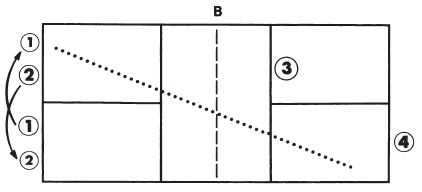February Newsletter 2019
GM Letter
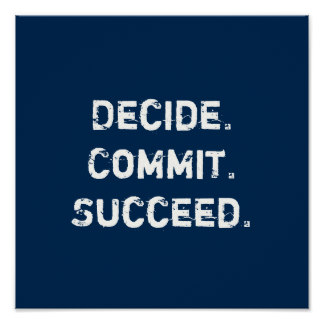 Dear Members,
Dear Members,
February
has been another busy month for construction with the conversion of the
pickleball courts beginning as well as a complete upgrade of the
filtration system for the pool. Construction of the Pickleball courts
began last week but has been slowed down by of the rain. At this time,
we estimate that the courts will be available to play on in the first
week of March. Exactly when they will open will depend on whether or not
we get more rain in the next couple of weeks. Once we have a definitive
date for them to open, we will schedule a grand opening with food,
drink and lots of pickleball action. Look for an announcement shortly.
I
am excited that many members have taken our advice on HIIT training and
begun taking advantage of the Sprint 8 program on the new Matrix
equipment. These short duration but high intensity interval training
(HIIT) workouts produce great results. Members have begun some friendly
competitions and started comparing each other’s “sweat scores”. A few of
our skiers have indicated that their early season runs on the slopes
seemed easier than past years and a couple of our tennis players have
indicated that it has helped them on the court! As more and more members
adopt this type of training I am sure we will hear about other “quality
of life” improvements. Keep up the good work!
With all of the
rain over the past couple of weeks there have been some questions about
our policy for alerting members when the courts are available for play.
We begin by sending a text via Rainedout.net announcing the courts are
closed. If you are not on RainedOut just ask the front desk for
directions on how to register. In the initial e-mail we either indicate
that we will provide updates as the conditions change or we estimate
when the courts may reopen. Please keep in mind this is an estimate and
can easily change. The courts are evaluated individually and are
released for play by the front desk staff once it is determined they are
completely dry. Occasionally a few courts dry earlier than we expect.
If this occurs we allow members that are in the clubhouse to use the
courts but ask them to vacate the court at the time of the next
reservation. It is rare that the courts are available earlier than
expected so we do not recommend members come to the club early in the
hopes of getting a court.
Many of us have taken the
opportunity to watch the Elite Olympic Triathletes that are training at
the club. They are amazing! If you are interested in picking up a few
swimming tips we suggest you consider coming in to see a workout. Their
workouts are Monday to Friday from 9 to 10am if you are interested in
seeing some incredible athletes. We look forward to rooting them on at
the 2020 Olympics in Tokyo!
Have a Healthy Day,
John Sutcliffe
General Manager
Car Break in Warning

Over the past couple of months we have had a number of cars broken into in both the parking lot and on the street. In each of these cases either gym bags or other valuables have been left visible in the car for the thieves to see. These are smash and grab thefts that only happen when the thieves see something they think is valuable. We do not recommend that you leave anything visible in your car while you are in the club. We are looking into security cameras that we hope will be a deterrent to the thieves but even after they are installed we do not recommend that you leave anything visible in your car.
Upcoming Events:
• Mardi Gras Party March 3rd 3-6:30pm (details to follow)
• Calcutta Tournament – March 29-31 (details to follow)
Healthy Living
How to Reset Your Life (and Have a Happier Year Than Last Year)
By Sabrina Walasek

Some people are steady-as-they-go types. I’m prone to trying new things. And the power of making my own choices somehow made it all feel less risky — until the day it didn’t.
Twice, my husband and I left our jobs and home to spend a year traversing the globe. In 2010, we moved to Colombia and ended up spending four amazing years there. And when we returned to the States, I jumped right back into the flow, working on a creative project with awesome people. Life was good!
Then, that company suddenly closed shop.
Most of the team moved on to an industry giant. That was not my jam. I decided to pursue a personal passion instead. I found contract gigs to keep me afloat. I tried several strategies to gain entry into my desired industry, but I was met with obstacles each time.
My previously sure-footed faith failed me. Life didn’t flow; it wobbled. The constant search for gigs while pursuing my dream was creating anxiety. I became tentative, questioning every decision I made.
According to the Cleveland Clinic, experiencing big changes or too many within a brief time period can create a perception that we are not in control of important events. This perception contributes to low self-esteem and even the development of anxiety or depression. When a single change throws us off kilter, it often doesn’t take us long to regain “control.” But when we’re knocked off our foundation, it takes patience and self-compassion to truly right ourselves.
Balance can be restored, though, and mindfulness provides us with one path to get there. If you’re using the new year as a way to regather (and feel like yourself again), then let me share with you how I reset my course for 2019.
1. Changing Thoughts Changes Reality
First, I paid attention to my thoughts and words. Yep, I was brooding on my “failed” career pivot and being really hard on myself. There is a saying, “Where attention goes, energy flows.” I was succumbing to negativity and dismissing the greatness in my life.
I noticed one word in particular was warping my reality: “should.” And the real negative power of that word was that it was subversively affecting my sense of self:
• I should be making more money (I’m a loser).
• I should have a larger network (I’m unimportant).
• I should be more dedicated (I’m lazy).
• I should be more skilled (I’m irrelevant).
• I should stick to what I know (I’m foolish).
According to Psychology Today, the word “should” undermines our ability to do what we want to do and causes a host of negative feelings: blame, guilt, anxiety, stress.
• Using “should” with ourselves is disempowering.
• Using “should” toward others provokes anger and resentment.
Once I realized all this, I vowed to stop using the word “should” — which was harder than I thought it would be. It’s surprising how often “should” is used in conversation.
So, since the best way to break a “bad” habit is to replace it with a “good” one, I started replacing “should” with “could” or “want to.” For example, “I should run three days a week” feels obligatory. If I don’t, I fail. (Plus, it goads me into rebellion.) Changing to, “I could run three days a week” means if I run twice, I own that; no guilt. I could run four times. Either way, it’s my choice.
This small adjustment helped me realize I was in control of much of my daily experience. I could grow my network. I want to learn a new skill. I could stick to my current career and grow my passion on the side.
Your Action Item: Notice how often you use “should.” What reaction does it conjure? Would it feel different if you tried “could” or “want to” instead?

2. Get Curious
Another part of my using mindfulness to reset my course was to stop taking things personally. I now choose to get curious. Instead of jumping to conclusions about situations or people, I stopped assuming. I took the time to sit with my life’s roadblocks to gain perspective. I got quiet, took deep breaths, and asked myself: “What if this struggle is critical to my journey and my personal growth?”
To encourage myself to be less judgmental and more curious, I contemplate these questions:
• What would my compassionate self say to my critical self?
• Could any positives develop from this experience?
• How does the struggle make me a better person?
Struggles are essential. They provide us with new perspective. Often, that “wrong turn” steers us to new and positive possibilities. Obstacles remind us to let go of the urge to control everything.
Your Action Item: The next time you find yourself in a tug-o-war with life, stop and consider the underlying gift. Be kind to yourself and see if you can identify the value the experience may bring, even if it’s simply how to avoid something similar in the future.
3. Assessing Your Whole Life
Lastly, instead of obsessing on my profession pathos, my course reset involved taking on a well-rounded approach to assessing my life. I selected The Six Dimensions of Wellness, developed by Dr. Bill Hettler of the National Wellness Institute. The six dimensions of life examined in this tool are:
• Occupational
• Physical
• Social
• Intellectual
• Spiritual
• Emotional
In my assessment, I acknowledged the positives I experience in each area. Turns out, I am flourishing in many dimensions of life. Who knew?
Discovering this has helped me build energy and motivation to take on the areas of my life that score lower. And it’s helped me see how I can combine my passion with the different dimensions of wellness. I realized I could take courses and attend workshops to both build my network and put my passion into practice until the universe is ready to open the right door for me. (P.S. The universe did exactly that about a week after I “let go.” Out of the blue, a paid opportunity came to me with more ease than I could have imagined.)
When we dwell on negativity, everything in and around us is impacted. By looking for the positives, we embody more balance and strength. We are able to see how rich and multi-dimensional our lives are. Seeing these bountiful parts helps to offset the struggling parts.
Your Action Item: Review the six dimensions and list all the positives that make up your reality. Embrace the abundance. If you feel there is an area that could use a boost to keep life more balanced, explore steps you “could” take to fill in gaps.
Here’s to Flowing Through a Happier Year
Through awareness, mindful speech (to ourselves and others), contemplation, and self-compassion, we can steady ourselves when the unexpected hits. The “bad” stuff will always still happen — but when we get clear, curious, and positive, we keep on flowing
Chickpea Polenta with Olives
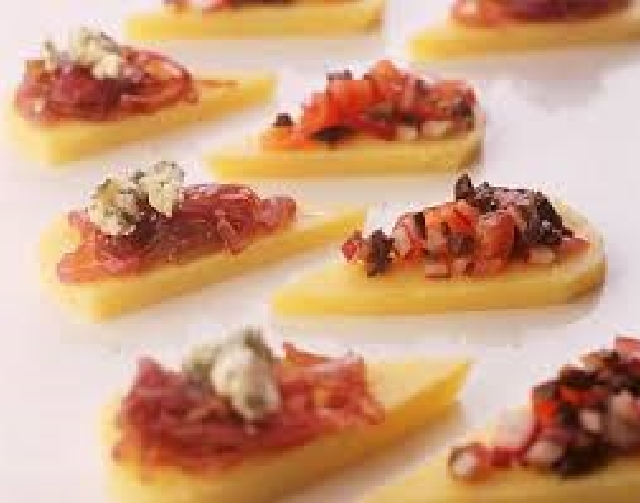
Number of servings
Serves 8
Ingredients
For the polenta:
• 1 3/4 cups chickpea flour
• 2 cups plain soy milk
• 1 cup chicken stock, vegetable stock or broth
• 1/2 tablespoon extra-virgin olive oil
• 3 cloves garlic, chopped
• 1 tablespoon chopped fresh thyme, oregano or basil, or 1 teaspoon dried
• 1 teaspoon dry mustard
• 1/4 teaspoon freshly ground black pepper
• 3 egg whites
For the topping:
• 1/2 tablespoon extra-virgin olive oil
• 1/2 yellow onion, minced
• 1/4 cup coarsely chopped pitted Kalamata olives
• 1/4 cup dry-packed sun-dried tomatoes, soaked in water to rehydrate, drained and chopped
• 2 tablespoons grated Parmesan cheese
• 2 tablespoons finely chopped fresh flat-leaf (Italian) parsley
Directions
In a blender or food processor, combine the flour, soy milk, stock, olive oil, garlic, thyme, mustard and pepper. Process until smooth. Pour the batter into a large bowl. Let stand for 1 hour in the refrigerator.
Heat the oven to 425 F. Lightly coat a 9-by-13-inch baking pan with cooking spray.
In a large, spotlessly clean bowl, using an electric mixer on high, beat the egg whites until stiff peaks form. Gently fold the egg whites into the batter.
Pour the batter into the prepared pan. Bake until puffed and lightly browned around the edges, about 15 minutes. Let cool for 15 minutes.
Heat the broiler. Position the rack 4 inches from the heat source.
While the polenta is cooling, make the topping. In a small frying pan, heat the olive oil over medium-high heat. Add the onion and cook until soft and lightly golden, about 6 minutes. Add the olives and tomatoes and cook for 1 minute. Remove from the heat.
Carefully spoon the onion mixture evenly over the baked polenta and sprinkle with the cheese. Broil until the top is lightly browned. Watch carefully; this takes only about 1 minute. Sprinkle with the parsley. Transfer to a wire rack and let cool for 10 minutes. Cut into 8 squares, then cut the squares on the diagonal into 16 wedges. Serve immediately.
Nutritional analysis per serving
Serving size: 2 wedges
• Total carbohydrate 20 g
• Dietary fiber 3 g
• Sodium 160 mg
• Saturated fat 1 g
• Total fat 5 g
• Trans fat 0 g
• Cholesterol 2 mg
• Protein 8 g
• Monounsaturated fat 2 g
• Calories 157
• Added sugars 0 g
• Total sugars 4 g
Roasted Blueberry Bites and Homemade Coconut Butter
By Sandy McCall
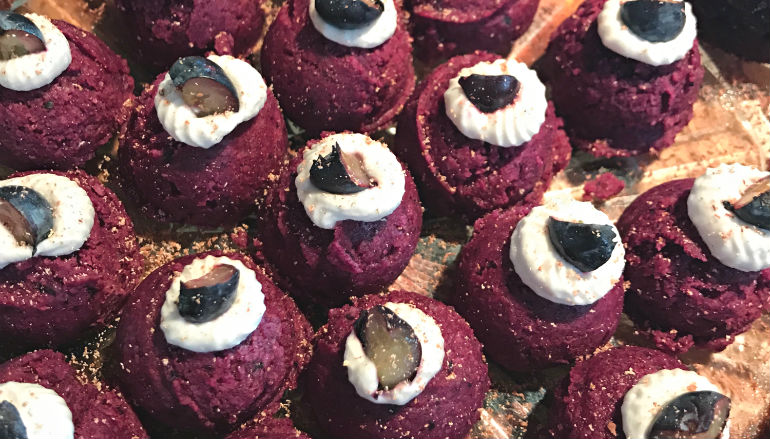
We all like simple, yet nutritious foods and this recipe for roasted blueberry bites is top on my list — plus, it’s a dessert!
I am always looking for healthier desserts and I also love it when a recipe doesn’t taste too sweet. These blueberry bites have a nice amount of sweetness coupled with the tang of citrus in each bite.
Often it seems, desserts are vilified — and rightly so if they contain sugar and some other ingredients that are not good for us. In contrast, this healthier dessert contains fresh blueberries and citrus juice and a small amount of monk fruit sweetener. It also includes one of my new favorites — coconut butter — and a couple of other quality ingredients.
Blueberries are a good source of vitamins K and C, as well as manganese and plant compounds such as anthocyanin. I have read that coconut contains vitamin C, calcium, and iron. Coconut also contains potassium, folates, riboflavin, thiamin, copper, and magnesium. And, of course, all the goodness of the coconut oil and citrus, too!
Perhaps this is a recipe that you might add to your short list of beneficial desserts?
I am always looking for healthier desserts and I also love it when a recipe doesn’t taste too sweet. These blueberry bites have a nice amount of sweetness coupled with the tang of citrus in each bite.
Category Dessert, Gluten Free, Vegan, Vegetarian
Prep Time 10 minutes
Cook Time 15 minutes
Total Time 25 minutes
Servings 12
Author Sandy McCall
Ingredients
• 6 oz fresh blueberries
• 1/2 cup coconut butter you can buy or make the recipe below
• 1/2 cup coconut oil
• 1/8 cup monk fruit adjust according to sweetness of blueberries
• 1/2 tsp vanilla extract
• 1 Tbsp lemon juice
Instructions
1. Preheat the oven to 350 degrees Fahrenheit.
2. Put blueberries on baking sheet lined with parchment paper.
3. Bake about 15 minutes or until blueberries pop open.
4. Put all ingredients in food processor or small blender and process until smooth.
5. Line a 6.5x9” dish with parchment paper by cutting parchment in two pieces. Lay one piece in each direction of the pan. (The idea is that after the ingredients are refrigerated, you can lift the entire piece onto a cutting board and cut into bite-size pieces.)
6. Spread the blueberry mixture over the parchment paper.
7. Refrigerate for one hour or until mix has hardened.
8. Lift from the container by holding the ends of the parchment paper and lowering onto a cutting board. Cut into 12 squares.
9. Store covered in the refrigerator.
Recipe Notes
If you want to be fancier, try refrigerating until set but still soft. Use a 1” disher (small ice cream scoop) to shape into small balls that are flat on the bottom. Arrange on a serving dish and top with a small amount of whipped coconut cream. Top with small piece of reserved blueberries.
Did You Know?
Showcase Your Business
Looking to promote your business? There isn’t a better place then your home club. You’re a member here at the club, so you already know how great it is, but here’s some added information to show you how we can get the info out about your business.
As you’ve seen, California Athletic Clubs has poured money into our club with a beautiful social deck, bar area, TV's, outdoor gyms, pool deck, locker rooms, and fitness room. With these advancements in the club, our 650+ members are spending more and more time not just using the facilities, but also hanging out in our social areas. This increased traffic is great for marketing your business. In addition to our membership we host three big events that bring in outside players/spectators to the club, that are prime marketing opportunities.
The three big events we have coming up for 2019 are:
- May 11-12 Junior Tournament (USTA Level 5 Open Tournament)
- May 27-June 2 Adult Tournament (USTA National 45's Hardcourt Championships)
- Aug 2-4 Junior Tournament (USTA Level 4 Open Tournament)
The Junior Tournaments typically brings in players, families, and coaches from all over Southern California. 50% within 15 miles, 40% within 50 miles, 10% outside 50 miles. The May Junior Tournament brings in around 150 entries, and the August Junior Tournament is around 250. In addition to all of the families we still have our full membership visiting the club for both using the facilities and watching matches.
The Adult Tournament in May/June engages locals to come watch the action. At least half of our 650 plus membership comes to watch the week long tournament. Every year 100-200 people from the community also visit the club to see the action. Along with daytime play, the tournament has four dedicated evenings to watch prime time matches.
Here are some ways that we can highlight your business:
• Naming Rights for a Tournament
• Naming Rights for a Tournament Viewing Night
• Award Ceremony Recognition
• Exhibit Space
• Display Marketing Materials
• Banners
• Newsletter Mentions
• Tournament Post Card Mailers
• Social Media Post
• T-Shirt logo
• Press release
We look forward to seeing which ways we can get great exposure for your business. Please contact Tennis Director Chris Dudeck for additional information.
Chris Dudeck
Tennis Director
Westlake Athletic Club
310-621-0720
[email protected]
Target Heart Rate
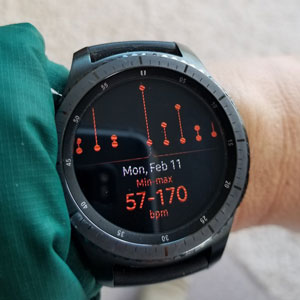
When you exercise, your heart rate speeds up to meet your body’s energy needs. If you know your target heart rate, you can make sure you are exercising hard enough to get a good workout, but not too hard to strain your heart.
To experience the health benefits of aerobic endurance training, you should participate in prolonged aerobic exercise (eventually 20 to 60 minutes of continuous training) at an intensity that is 50 to 85% of your maximum training heart. We refer to that as your “Target Heart Rate Zone.” If your target heart rate is too high, you’re straining your heart. So slow down. If it’s too low, and the intensity feels too light, push yourself to work a little harder.
Why a range and not a single number? It depends on your fitness level. If you haven’t exercised in a while or recently started, aim for a heart rate on the low end of your target heart rate, 50% to 65% of your maximum. If you are a regular exerciser, you should be in the middle of your range, 60% to 75% of your max. Very active people can pump to 70% to 85%, on the high end of the range.
To determine your target heart rate zone determine your maximum heart rate by subtracting your age from 220 and then multiply that number by 50% and 85%. Your heart rate zone falls between these 2 numbers.
Now that you know your target heart rate range, you can check your pulse at regular intervals (every 5 to 7 minutes) during the workout session to be sure you are in the target zone. If your exercise heart rate is below the target range, increase your pace or effort slightly to achieve the proper intensity. If your exercise rate is above the target range, decrease your pace or effort slightly to remain in the range. Your target heart rate range is not an absolute, but it’s a good tool to help ensure you are getting the maximum results from your cardiovascular workouts.
| Age | Target HR Zone 50-85% | Average Maximum Heart Rate, 100% |
| 20 years | 100-170 beats per minute (bpm) | 200 bpm |
| 30 years | 95-162 bpm | 190 bpm |
| 35 years | 93-157 bpm | 185 bpm |
| 40 years | 90-153 bpm | 180 bpm |
| 45 years | 88-149 bpm | 175 bpm |
| 50 years | 85-145 bpm | 170 bpm |
| 55 years | 83-140 bpm | 165 bpm |
| 60 years | 80-136 bpm | 160 bpm |
| 65 years | 78-132 bpm | 155 bpm |
| 70 years | 75-128 bpm | 150 bpm |
Slow and in Control

Studies show that lowering the weight is just as important as lifting it. Going slow causes just as much muscle-cell damage as lifting it.
Why go Slow? The reason for wanting to go slow and in control is this: In any weight lifting exercise there are two basic motions. One is the concentric phase, or simply put, the lifting phase. The other is the eccentric phase, or the lowering phase.
During the lifting phase the muscle shortens and contracts. During the lowering phase the muscle lengthens. Lowering the weight causes just as much muscle-cell damage as lifting the weight does. The muscle-cell damage followed by the repair is how the muscles grow.
Those of you that are lifting the weight up and down quickly are risking serious injury to yourself and are not getting the full benefits out of your weight lifting routine.
So even though you may feel like it’s effortless to lower the weight while you are lifting, your muscles are still working and contracting, except just eccentrically or negatively.
You may want to consider slowing down the eccentric portion of your repetitions during your workouts and really concentrate on lowering the weights slowly and completely under control. Try lowering the weight very slowly and deliberately for a count of maybe 4-5 seconds and then explode up slower 2-3 second count.
You won’t be able to perform as many repetitions as you usually do with the same weight so you’ll need to use a lighter weight. But if done properly, you’ll get a great stretch and pump and chances are you will feel it the next day.
Fitness Corner
HIIT - Peter Loncto
In the last Newsletter John wrote about the recent upgrades here at the Club. Our new outdoor cardio offers a wide selection of equipment.... rowing machines, S-drive treadmills, upright and recumbent bikes, and Matrix Ascent trainers. All offer varying degrees of challenge to help anyone at any level to get that daily dose of cardio exercise done.
Incorporated in the Matrix gear is a program called Sprint 8. This High Intensity Interval Training model allows the user to achieve maximum results in a minimal amount of time. In a 20 minute session, 3 times per week, you can dramatically reduce your body fat, increase your cardiovascular health, and lose inches off your waistline.
There are many benefits of this method of training:
1) It’s great for busy people
2) It’s very effective for fat loss...especially abdominal fat
3) It stimulates anti-aging hormones
4) It builds endurance faster
5) It’s superior in preventing and controlling high blood pressure
6) It reduces risk of diabetes, heart disease or stress
7) It suppresses your appetite
8) You’ll see results faster
9) It boosts your metabolism
10) It helps lose fat while preserving muscle
11) It’s great for people with a short attention span
Hard to believe that you can derive all these benefits from a 20 minute workout out of which there are a total of only 4 minutes of hard work!
In the upcoming months we will begin offering half hour long High Intensity Interval Training Sprint 8 group training classes. Keep your eyes open for the schedule. You will love the changes to your overall health and wellness. Let’s HIIT it!!!!
Reconnecting with Our Health & Fitness Goals
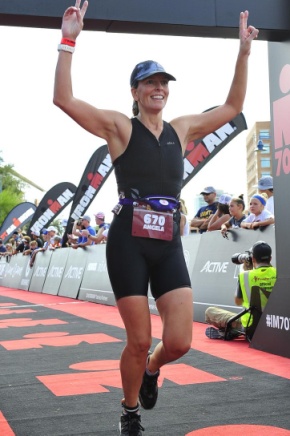
By Angie Hoehne
When our calendars flip over to a new year, it feels like time is giving us all a new opportunity to achieve great things during a fresh period filled with new days. Gyms fill with eager bodies wanting to strengthen up and drop excess inches, diets begin, behaviors change, etc., then something happens. Life happens. Children get sick, work gets busy, spouse gets grumpy, dog eats the running shoes, etc., and we find ourselves surrendering back to the status quo, waiting for inspiration to strike again.
Instead of demanding perfection from ourselves all of the time then scrambling for our comfort zones when life’s obstacles strike, what if we strived for simply “better” and swayed with the ying and yang of universal forces in a more tolerant manner? What if every reset button was “Monday” instead of “January 1”? We tend to be the toughest critics on ourselves, yet we are also the ONLY ones responsible for our own health and fitness levels.
Sadly, I have noticed a trend over the years that most resolutions for improved health and fitness do not survive the decadent Valentine’s Day dinner. All of the hard work from Jan 1 through Feb 14 seems to vanish on the scale when sunlight hits Feb 15th. Water weight and undigested food play a mean trick, although it is a temporary one. Fat is fat; muscle is earned; water weight and food in the system are temporary… Remember this and reconnect with your health and fitness goals for the sake of your life and performance goals. Perhaps simply plan to begin the new Monday as a healthier human being than you were last week, and do the best you can to improve on a daily basis with the time and resources you have available on that given day… perfection is not the goal; Rather, a healthier and fitter YOU is worth striving for!
Please feel welcome to ask the front desk for more information on ways myself or another trainer might be able to assist you in planning a safe and effective customized plan for you to chip away at your goals for improved performance and health! See you at our club!
Tennis Corner
THE OJAI. Don't miss it this year. April 24-27
By Karl Akkerman

The Ojai. Many of you have heard about it but just never made the trip to experience the oldest and largest Invitational Tennis event in the USA. I am talking about one of the premier tennis events in Southern California that you definitely should go and see the next Net Generation of great players in the future.
The 119th Year of The Ojai will run from April 24-27 in Ojai California. It is a small city just Northwest of Ventura up in the hills. It may be a small city, but it is the largest and most exciting tournament you that you may ever attend. The atmosphere is unique with tradition and high energy that rivals the Fed and Davis Cup. It is a great opportunity to bring your juniors to watch and inspire them to be a part of collegiate tennis. The best tennis viewing is at Libby Park where the PAC 12 college championships are being held. The tournament includes Divisions of juniors, High School CIF championships, community college, Independent Colleges, Division III, and Division I players. There is also a Professional/Open division where upcoming pros and retired pros come back to play and pick up a few bucks while the get to play in a tournament they played as a junior 10-20 years ago. When I tell you it is the largest invitational in the nation, you will understand why they have 8 different clubs, parks, high schools, and many private courts in just Ojai. They also utilize 4 large tennis venues in Ventura, and 4 big tennis sites in Oxnard as well during the week. There are about 1,500 competitors in this tournament. But it all culminates on Saturday and Sunday at the Libby Park for the Pac 12 Championships. This is the highlight of the tournament where the Pacific Coast top teams play off as a team to take home the Pac 12 Title. There is also a Professional/Open Level at the Ojai Valley Inn and Spa on Saturday and Sunday. The Ojai Men's and Women's Open money event in 2019 will be more than $30,000 to be handed out to the top finishers in both divisions equally. And this year will be the first year that the tournament will hold the Community College State Championships as a team and individual titles. This year the tournament will be honoring Larry Scott the Pac 12 Commissioner. There will be dinner honoring him and there is also usually is on the Thursday for a BBQ in Libbey Park. Check the website for more details.
I have been up to "The Ojai" over 20 times over the years and it is worth the drive. Future top ATP and WTA players in the world will be there. Many of the greats of tennis have played in Ojai, including Bill Tilden, Tony Trabert, Bobby Riggs, Jack Kramer, Arthur Ashe, Billie Jean King, Pancho Gonzales, Alex Olmedo, Stan Smith, Jimmy Connors, Tracy Austin, Michael Chang, Lindsay Davenport, Pete Sampras and the Bryan twins. The “Wall of Fame” at the grandstand in Libbey Park names 89 players who competed at Ojai, and won one or more of the major championships which make up the tennis “Grand Slam.”
It is an amazing community event. The entire town gets involved. There are over 600 volunteers used to help run the tourney. The environment is intimate because you will see up close and personable top college coaches Like UCLA Billy Martin, USC Peter Smith, Paul Goldstein from Stanford along with100 year old oak tress throughout the venues. You can talk with all of them and snap a picture with them or their players. You are in the Ojai valley that is surrounded by the Topa Topa mountains looking down at you that is just stunning. You will see team spirit like no other tournament with load cheering that rivals the Davis and Fed Cup atmosphere. Tennis Channel will be there and Celebrities like Chris Evert, Rod Laver, Pam Shriver have been known to show up.
I am never disappointed. The weather is always amazing and the play, venues, food, wine are all fantastic. You are up close and personal. It is traditional to serve you orange juice in the morning and a proper tea with cookies in the afternoon. All is free with your admission for $10 for Wednesday, $15 for Thursday/Friday and only $20 for weekends. Parking is free. Can't beat that. You can also buy a 5 day pass for just $50. Let me encourage you to stay up there over night. There are many really nice places to stay in Ojai or nearby Ventura which is a quaint beach town.
So organize a road trip with some friends or your kids friends and be amazed at some great tennis with future and past tennis stars who regularly play in the Open Division. Those of you that have very high performance kids have gone up I am sure, but those who have never gone or know very little about this tournament need to add it to your résumé of great tennis experiences. It is a pleasant trip up the coast to see this historical tennis event.
Check it out at his links to see where and when and where all the players will be playing.
http://theojai.net/
Here is a link info about the rich history of The Ojai. You will be surprised and entertained.
http://www.ojaitourney.org/history/
See you on the courts up there.
Karl Akkerman
Westlake Athletic Club
USPTA Elite Professional
USPTA District 1 President 2018
805-302-7523 cell or text
Split Step
Pickleball
Pickleball Popularity on the Rise
Pickleball continues to rise in popularity and is considered to be the fastest-growing sport in America. More than 3 million players play pickleball in the United States and that number has been growing by more than 10 percent each year over the past decade.
There are a number of different reasons for the continued growth in pickleball. First, the ease of entry into the sport. A rather short and flat learning curve enables people to rapidly pick up the game and quickly start playing with their family and friends. Second, the social aspect of the sport draws many into the sport and often leads to a whole new group of friends to hang out with. Finally, pickleball is a fast paced game that can be a terrific cardiovascular workout.
How To Play Pickleball
Pickle-ball® is played on a badminton-sized court: 20’ x 44.’ The ball is served diagonally (starting with the right-hand service-square), and points can only be scored by the side that serves.
Players on each side must let the ball bounce once before volleys are allowed, and there is a seven-foot no-volley zone on each side of the net, to prevent “spiking.” The server continues to serve, alternating service courts, until he or she faults. The first side scoring eleven points and leading by at least two points wins. Pickle-ball® can be played with singles or doubles.
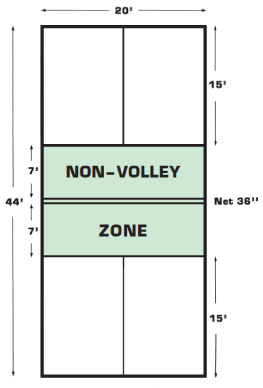
The Pickleball Serve
Serves are to be made diagonally, starting with the right-hand service-square and alternating each serve. The serve must clear the seven-foot non-volley-zone in front of the net and land in the diagonal service court.
Serves should always be done underhand with the paddle below the waist, and the server must keep both feet behind the back line when serving. The ball should be hit into the air without being bounced. The serving side will continue to serve until the there is a fault on the service, at which point the service will be given to the opposing side. (However, if the ball touches the net but still lands within the appropriate service court, the serve may be taken over.)
The Server must keep both feet behind the back line when serving. The service is made underhand with the paddle contacting the ball below the waist. The Server must hit the ball in the air on the serve. The Server is NOT allowed to bounce the ball and hit it off the bounce. The service is made diagonally cross court and must clear the non-volley zone, including the line (A serve that hits the non-volley zone line is out) Only one serve attempt is allowed, except if the ball touches the net on the serve and lands in the proper service court,in this case the serve may be taken over. At the start of each new game, the 1st serving team is allowed only one fault before giving up the ball to the opponents. Thereafter both members of each team will serve and fault before the ball is turned over to the opposing team. When the receiving team wins the serve, the player in the right hand court will always start play.
Volleys
To volley means to hit a ball in the air without first letting it bounce. In Pickle-ball®, this can only be done when the player’s feet are behind the non-volley zone line (seven feet behind the net). Note: Is is a fault if the player steps over the line on his volley follow-through
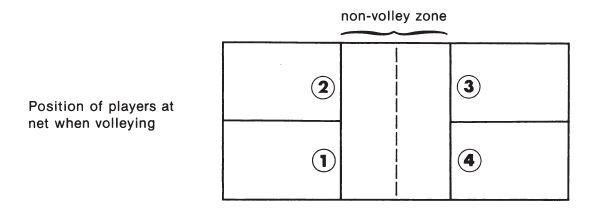
Double-Bounce Rule
Also called the Two Bounce Rule, each team must play their first shot off of the bounce. That is, the receiving team must let the serve bounce and the serving team must let the return of the serve bounce before playing it. Once these two bounces have occurred, the ball can either be volleyed or played off the bounce.

Fault
A fault is committed when the ball:
• Touches any part of the non-volley zone on the serve (including the line).
• Is hit out of bounds
• Does not clear the net
• Is volleyed from the non-volley zone
• Is volleyed before a bounce has occurred on each side
Scoring
A team shall score a point only when serving. A player who is serving shall continue to do so until a fault is made by his/her team. If playing doubles, each player on a team shall keep serving until their team makes a fault, then the serve moves to the opposing team - this is called a Side Out. The game is played to 11 points, however a team must win by 2 points.
Player Position for Doubles At Start Of Game
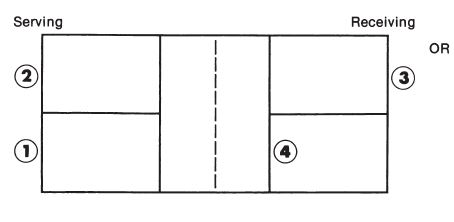
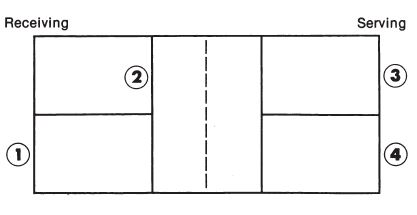
Double Play Positioning Movements
In Image A below, you can see that Server (player 1) serves from the right hand side of the serving team's court diagonally across court to the Receiver (player 3)in the opposite right hand side of the court. The receiver (player 3) must let the ball bounce before returning the serve. The serving team must also let the return bounce before playing it (the Double Bounce Rule). After two bounces have occurred, the ball may then be either volleyed or played off the bounce until a fault is made.
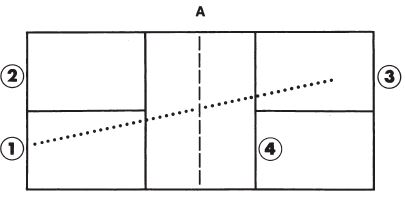
In Image B below, you can see that after a fault is made by the receiving team, and a point is scored by the serving team, the serving team's players switch sides of court and the same player will continue to serve. When the serving team makes its first fault, the serving team's players will stay in the same side of the court, and the second partner will then serve. When they make their second fault, they will stay in their same court positions, and turn the ball over to the other team. Players switch sides of the court only after scoring.
